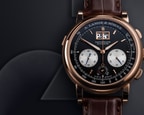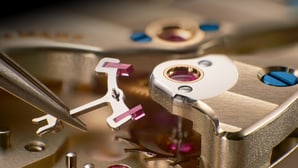The ZEITWERK is a mechanically driven digital-display watch. Its trailblazing concept with precisely jumping numerals is unparalleled in watchmaking.
Mechanically sound thinking
Lange’s patented jumping numerals mechanism overcomes these weaknesses. As usual in digital watches, it displays the time from left to right. The long-term functional integrity of the design is assured by a fly governor that absorbs the surplus energy after every switching cycle.
01 The German silver time bridge
02 Colourless sapphire-bearing jewel
03 Tens-minute disc with the numerals 0 to 5
04 Units-minute disc with the numerals 0 to 9
05 Hour ring with the numerals 1 to 12
Functional principle
In the interest of optimised legibility, the hours and minutes are displayed in the same size on the same axis. The minutes are displayed with two discs. The units-minute disc (04) with the numerals 0 to 9 and the tens-minute disc (03) with the numerals 0 to 5 share the same axis. A constant-force escapement assures precise minute steps. Every 60 seconds, with a driving wheel and a pinion on the same arbor, these steps are transmitted to the disc configuration as instantaneous fifths of a revolution (72 degrees).
The abruptly jumping pinion engages with a wheel that carries the units-minute disc. In turn, this wheel engages with the wheel of the tens switching wheel. Connected with the switching staff, it carries a finger with a jewel on its underside. After every rotation of the units-minute disc – every ten minutes – the jewel engages with the six-tipped switching star of the tens arbor and advances it with the minute step of the units-minute disc from 9 to 0 by one-sixth of a revolution (60 degrees). This causes the tens-minute disc to move forward by exactly one numeral.
To prevent the inadvertent movement of the tens arbor outside the switching phase, the switching staff and tens arbor feature two positive form-lock safety elements. However, an additional safety element for the units-minute disc is not needed because it is directly connected with the control pinion of the constant-force escapement, which is immovable outside the switching phases.
After a full revolution, the tens arbor advances the large hour ring (05) with the numerals 1 to 12. For this purpose, it carries a wheel with merely one tooth that engages with the four-tipped switching star of the intermediate hour wheel. When the tens-minute disc transits from 5 to 0, the intermediate hour wheel is advanced by a quarter turn (90 degrees). In this case, too, a positive form-lock safety element between the tens arbor and the intermediate hour wheel assures that the hour ring cannot move inadvertently.
The exceptional construction calls for an innovative time-setting mechanism: When the movement is stopped by pulling the crown, the control lever of the constant-force escapement blocks the entire disc configuration. An innovative ensemble overrides this blockade; it deviates from the classic hand-setting mechanism.
The process of setting the time moves a roller across the tips of the contrate hub that is held by the driving wheel. Thereby, the arbor firmly connected to it rotates in accurately defined steps. This allows the indication to be adjusted incrementally in complete minute steps. The sapphire-crystal caseback reveals the hops of the roller along the contrate hub.
Explore further




Exclusive insights into the world of fine watchmaking
Experience A. Lange & Söhne’s fascinating heritage, unique stories and exquisite timepieces by subscribing to our newsletter.
How can we be of service?
Whether you are in search of a specific model, have questions out of interest or need a service request for your timepiece – we are delighted to help you. We are at your service by phone, email or in one of our boutiques.









